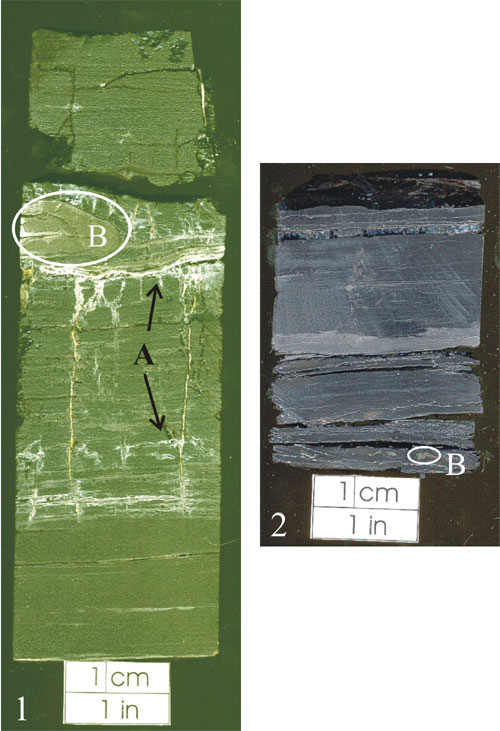 |
|
Kansas Geological Survey Open-file Report 2003-82 |
2.1.1 Coal Facies
Description
The coal facies vary from low ash coal to high ash coal to carbonaceous shale.
Diagnostic features of the coal are black color, moderately bright luster,
laminations (3-10 mm), and moderate to well developed cleats (Figure 2.03).
Diagnostic features of the carbonaceous shale are black color, moderately
bright luster, and laminations (3-10 mm). Cleat spacing can vary widely (0.25
to 2 inches; 0.6 to 5 cm). Cleats are typically mineralized with calcite,
pyrite and sulfur. Plant fragments are found throughout the facies. No trace
or body fossils were observed in the coal facies. The coals facies ranges
in thickness up to 6 feet (1.8 m). Lower and upper contacts are consistently
sharp.
Paleoenvironmental Interpretation
The close association with marine detritus or marine carbonate sediments can
explain the high-ash and carbonaceous nature of a coal. Peat growth exposed
to the marine or fluvial environment is interpreted to be the cause of the
carbonaceous shale or high-ash coals, while low-ash coal develops in mires
protected from marine and fluvial influence. Coal splits are an indication
of the margin of a coal seam and the margin of the mire. High sulfur contents
are an indicator of increased marine influence during the coalification process.
Historically, the coal facies would be interpreted as part of the “outside
shale” in the cyclothem model (Heckel, 1977).
 |
| Figure 2.03 - Polished core section showing the coal facies of the Riverton coal. Coal is laminated with variations in lithotypes and macerals. Note mineralization of calcite (A) and pyrite (B) along cleats and laminations. Sample 1 from 850' in the Cooper CW#1 well, 11-T35S-R18E, Labette County, Kansas. Sample 2 from 895' in the Hinthorn CW#1 well, 14-T32S-R16E, Montgomery County, Kansas. |
e-mail : webadmin@kgs.ku.edu
Last updated January 2004
http://www.kgs.ku.edu/PRS/publication/2003/ofr2003-82/chapter2_1.html